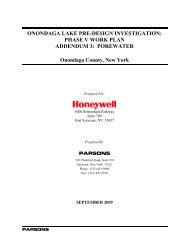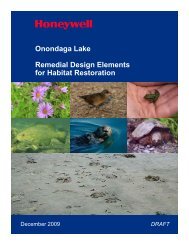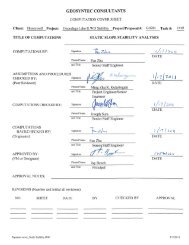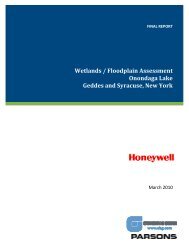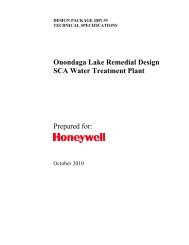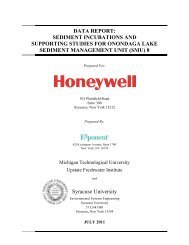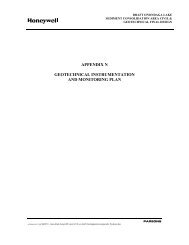Phase 1B Underwater Archaeological Report for the Onondaga ...
Phase 1B Underwater Archaeological Report for the Onondaga ...
Phase 1B Underwater Archaeological Report for the Onondaga ...
Create successful ePaper yourself
Turn your PDF publications into a flip-book with our unique Google optimized e-Paper software.
FINAL<br />
<strong>Phase</strong> IB <strong>Underwater</strong> <strong>Archaeological</strong> Resources <strong>Report</strong> <strong>for</strong> <strong>Onondaga</strong> Lake Superfund Site<br />
of boats were popular among Native Americans of <strong>the</strong> nor<strong>the</strong>rn latitudes, where <strong>the</strong> landscape is barren<br />
of trees and sea mammals played a major role in subsistence and cultural innovation.<br />
As freshwater inland lakes were established by 10,000 years ago, <strong>for</strong>ests of hard and soft wood species<br />
developed around <strong>the</strong> post-glacial lakes. Native Americans adapted <strong>the</strong>ir watercraft design to <strong>the</strong>se<br />
environmental changes. The Archaic and Woodland peoples built small craft from tree bark, skins from<br />
terrestrial animals, or hollowed-out logs. Un<strong>for</strong>tunately, few examples of watercraft from <strong>the</strong>se periods<br />
have been found, and little is known about <strong>the</strong>ir design, appearance, or use. Evidence of bark and skin<br />
boats has not been found in <strong>the</strong> archaeological record, since <strong>the</strong> organic materials from which <strong>the</strong>y were<br />
made are not preserved well in <strong>the</strong> climate of <strong>the</strong> area. At least a dozen dugout canoes, however, have<br />
been uncovered in lakes and ponds throughout Vermont and Ontario. The archaeological examples of<br />
<strong>the</strong>se simple boats probably date between <strong>the</strong> Late Woodland period (1100 to 400 BP) and <strong>the</strong><br />
nineteenth century.<br />
Watercraft made of dugout tree trunks, called dugout canoes, were <strong>the</strong> primary vessel <strong>for</strong>m starting<br />
about 10,000 years ago. 49 Dugouts were heavy, weighing between 200 to 300 pounds when wet and<br />
were difficult to carry at portages. They <strong>the</strong>re<strong>for</strong>e were primarily used on larger bodies of water, like<br />
lakes and ponds, though smaller, individual dugouts may have functioned well on rivers. Most of<br />
dugouts that survived in <strong>the</strong> archaeological record have been found submerged in ponds. It appears<br />
that <strong>the</strong>se vessels were cached, or stowed, over seasons when semi-sedentary groups of hunterga<strong>the</strong>rers<br />
would travel to <strong>the</strong>ir fall/winter camps. The dugouts would <strong>the</strong>n remain protected <strong>for</strong> when<br />
<strong>the</strong> group returned and <strong>the</strong> lakes and ponds were no longer iced over.<br />
By approximately 600 years ago bark canoes became <strong>the</strong> primary vessel type in <strong>the</strong> Nor<strong>the</strong>ast. An<br />
average bark canoe was approximately 16 feet (4.9m) long, but o<strong>the</strong>rs could also be as small as 11 feet<br />
(3.4m) or as large as 30 feet (9.1m). Regardless of <strong>the</strong>ir size, bark canoes were easier to handle, as <strong>the</strong>y<br />
were much lighter than dugouts, yet construction was more complicated and required more specialized<br />
tools and construction components. Bark was most easily harvested in <strong>the</strong> spring, when sap was<br />
running. Winter and summer bark was more difficult to harvest and inferior. 50 Gum or tallow was<br />
applied as a resin to make <strong>the</strong> vessels water tight. Un<strong>for</strong>tunately, <strong>the</strong> delicate nature of birch bark<br />
canoes has prevented any early specimens from surviving in <strong>the</strong> archaeological record. Anthropologists<br />
and archeologists agree that <strong>the</strong> bark canoe probably evolved out of <strong>the</strong> late Woodland period some<br />
2000 or more years ago. However, none has survived from be<strong>for</strong>e <strong>the</strong> 1700s.<br />
Haudenosaunee Canoes<br />
Haudenosaunee bark canoes were typically built of elm bark as opposed to birch bark. Birch bark was<br />
available, but scattered and <strong>the</strong>re<strong>for</strong>e elm and o<strong>the</strong>r barks were more common on Haudenosaunee<br />
canoes. 51 They may have used white cedar <strong>for</strong> <strong>the</strong> ribs and roots of <strong>the</strong> white cedar, tamarack, or<br />
eastern larch <strong>for</strong> sewing <strong>the</strong> pieces of <strong>the</strong> bark toge<strong>the</strong>r. 52 For more temporary canoes, saplings and<br />
branches may have served <strong>for</strong> <strong>the</strong> ribs. Early accounts note Haudenosaunee canoes as being ra<strong>the</strong>r<br />
large and primarily labeled as war canoes. 53 The war canoes may have been temporary canoes,<br />
constructed hastily <strong>for</strong> <strong>the</strong> task at hand and <strong>the</strong>n abandoned. On large bodies of water within <strong>the</strong>ir<br />
territory, <strong>the</strong> Haudenosaunee used dugouts, but <strong>for</strong> navigating streams and <strong>for</strong> use in raiding <strong>the</strong>ir<br />
enemies <strong>the</strong>y employed bark canoes (Figure 4). 54<br />
10



